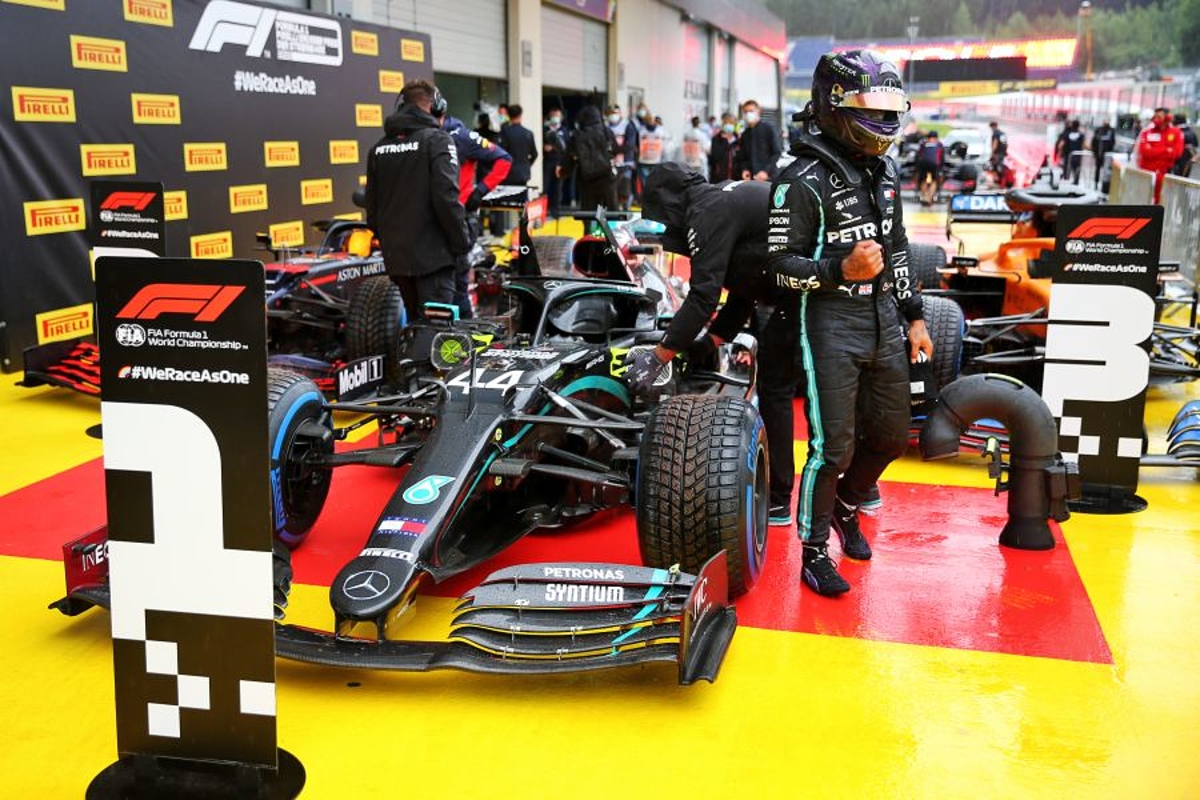Lewis Hamilton has described his pole position lap for the Styrian Grand Prix as "close to perfect", while Toto Wolff suggested it was "not from this world".
The fact Hamilton finished 1.2 seconds clear of Red Bull's Max Verstappen in appalling wet conditions underlines many aspects as to the qualities of the six-time F1 champion and a car he bemoaned after second practice that ultimately found the sweet spot.
So what goes into such a lap, that was arguably better than the one from qualifying two years ago at the Singapore Grand Prix that had many pundits waxing lyrical back then?
As Hamilton pointed out, the conditions were the "hardest we ever drive in, with just one small lapse in concentration and you're off, and it can be big or small, and there's more chance of it being a big one."
It is a credit to FIA race director Michael Masi and his team that qualifying went ahead following the deluge of rain that fell on the circuit throughout late morning and early afternoon, and that had red-flagged the F3 race after 15 laps and led to the cancellation of the final practice session.
Fortunately, there was a window of opportunity as the rain stopped shortly before qualifying, and although it returned by the start of Q1, it was not enough to soak the track again and make the circuit undriveable.
By Q3, however, the top 10 drivers were faced with the worst of the weather throughout the entire session, made clear by the fact Hamilton's eventual pole lap of one minute 19.273secs was slower than his leading times from Q1 and Q2.
The fact Hamilton 'purpled' all three sectors of his final run in Q3, when visibility was virtually zero, indicates that not only had he full confidence in his car, but in many respects, he was also driving by feel and instinct.
As Hamilton added: "The team did a great job in terms of positioning, in terms of the information I was getting, and I felt pretty much at home in the rain."
From Hamilton's perspective as a driver, he is reliant on the information he is being fed from the pitwall, and in particular, his race engineer Pete [Bono] Bonnington, with whom he has developed a close bond over the years.
In the conditions that prevailed in qualifying, Hamilton painted a bleak picture. He said: "You really feel very, very lonely out there because there's a cloud of spray ahead of you, and the same behind, so you don't know where anyone is, you don't know what time it is, all you know is you're going super fast."
It means he has to trust every piece of information he is being fed by Bonnington, who in turn has those around him at the track, and at 'mission control' back at Brackley supporting him.
"Communication really is vital, and the rapport you have with your engineer, that good relationship, that good understanding you have with each other, that's something I discuss," said Hamilton.
"Bono and I have learned over time how to lean on each other, so I think the communication was really perfect. I couldn't have done it without him."
Hamilton's remarks were echoed by Wolff, who was naturally full of praise for the relay of information of what took place under extreme circumstances.
"These conditions, where you really need to be sharp to advise the driver as to where the gaps are, how the weather develops, the driver feeding back what he sees on the track, the intercom protocol needs to be very precise," assessed Wolff.
"Obviously, it helps when an engineer and a driver have been working together for a long time and they trust each other because you are able to be very direct with your messaging because the relationship is solid.
"If you could hear the ballet that is going on over the intercom between everybody, on the pitwall and in the garage, then I'm really proud and impressed by what happened.
"It is about finding the right spot on the track, analysing the weather, deciding when to put the engine into recharging mode or when to deploy the party mode, which doesn't last for long, and that was perfectly synchronised today."
As mentioned, the car itself not only has to be dialled in, but the right amount of heat in the tyres is crucial to counteract the wet.
As witnessed with Racing Point's Sergio Perez, not enough and the performance simply isn't there as the Mexican was unable to escape Q1 in a car that in the dry suggested it was pushing for a top-five grid slot this weekend.
"I think tyre temperatures definitely play a role," added Wolff. "You could see that at the last line-up at the lights, some teams had very hot tyres and others not, so it's more about the set-up in the session itself.
"How do you get your tyres into the right temperature window because if you are not then you are lacking grip. If you overheat, then you are at the other end of the spectrum and that is equally as detrimental."
Yet as Wolff remarked, there was still something 'otherworldly' about Hamilton's performance.
As to why there was this eye-opening gap to the rest of the field, Wolff said: "I think driver and car merge into one where a perfect car with the tyres in the right window, and perfect driveability on the power unit come together with skill and the intelligence of a racing driver, and only then you see these kinds of performances."
Of course, this was not a one-off. We have been here before. Remarkably, of the last 13 wet qualifying sessions, Hamilton has taken pole on nine occasions.
While the car and tyres naturally play a significant role, on days like today, it is all about the individual, and Hamilton is head and shoulders above his peers in this regard.
But as to why he is so good in the wet...
"I think it's difficult for an athlete to explain why they're good at something," said Hamilton. "I know how good I am, and that's a belief you have to have inside of you, all of us. That's the same for every athlete.
"I think it should probably apply to everyone doing their jobs around the world; people try to be the best and believe that you can be the best and at some point, hopefully, you do believe you’re the best.
"But yeah, it’s down to focus, it’s down to how you study the track and your ability to be dynamic and manage the trickiest of conditions with the pressure on you.
"Naturally, in the dry, it's easier not to make mistakes, it's easier to stay on track, it's a lot less risk, even though there is a lot of risk, but it's magnified by a thousand once you get in the rain.
"And there's a balance as to how much risk you take. In the dry, you can take more risk because it's more forgiving, and in the rain there's very little forgiveness."
In terms of balancing risk and reward in the wet, Hamilton is without a doubt on another planet.
Before you go...
"Drugged up" Norris fearing painful Styrian GP will be "bigger challenge"
Leclerc given three-place grid penalty for impeding Kvyat
Related






 GP AUSTRALIA
14 - 14 Mar
GP AUSTRALIA
14 - 14 Mar

 GP CHINA
21 - 21 Mar
GP CHINA
21 - 21 Mar

 GP JAPAN
4 - 4 Apr
GP JAPAN
4 - 4 Apr

 GP BAHRAIN
11 - 11 Apr
GP BAHRAIN
11 - 11 Apr

 GP SAUDI ARABIA
18 - 18 Apr
GP SAUDI ARABIA
18 - 18 Apr

 GP USA
2 - 2 May
GP USA
2 - 2 May

 GP ITALY
16 - 16 May
GP ITALY
16 - 16 May

 GP MONACO
23 - 23 May
GP MONACO
23 - 23 May

 GP SPAIN
30 - 30 May
GP SPAIN
30 - 30 May

 GP CANADA
13 - 13 Jun
GP CANADA
13 - 13 Jun


























 Grand Prix of Austria 2025
Grand Prix of Austria 2025  Grand Prix of Belgium 2025
Grand Prix of Belgium 2025  Grand Prix of Hungary 2025
Grand Prix of Hungary 2025  Grand Prix of Azerbaijan 2025
Grand Prix of Azerbaijan 2025  Grand Prix of Singapore 2025
Grand Prix of Singapore 2025  Gran Premio de la Ciudad de Mexico 2025
Gran Premio de la Ciudad de Mexico 2025  Grande Prêmio de São Paulo 2025
Grande Prêmio de São Paulo 2025  Qatar Grand Prix 2025
Qatar Grand Prix 2025  Grand Prix of Abu Dhabi 2025
Grand Prix of Abu Dhabi 2025 